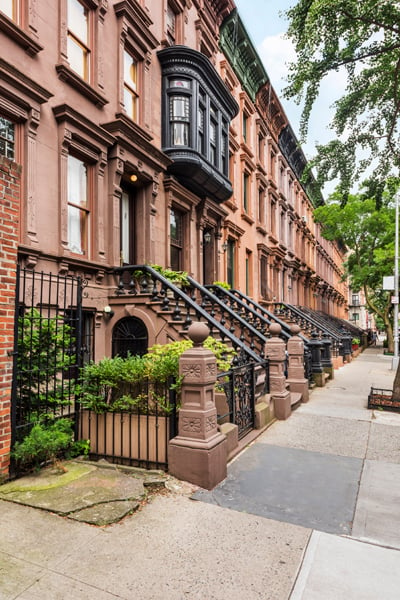If you’re considering a move to New York City, you may have heard the term “brownstone” thrown around a lot. But what exactly are a brownstones in New York City? And why are they so popular in New York City. In this comprehensive guide, we’ll answer those questions and more. We’ll cover the history of brownstones in New York City, the different types of brownstones, the benefits of owning a brownstone, and much more. So, let’s get started!
What is a NYC Brownstone?
At its most basic level, most brownstones in New York neighborhoods are a type of townhouse built from reddish-brown sandstone, first appearing in the mid-19th century. Popular among middle- and upper-class families, brownstones are found in neighborhoods like Park Slope, Brooklyn Heights, and Upper West Side. They are one of the defining features of New York City’s architecture.
Why are Brownstones so Popular?
Brownstones are a cherished part of NYC’s architectural heritage, known for spacious layouts , living spaces, charming details like decorative fireplaces and hardwood floors. They are typically located in desirable neighborhoods with high demand, great shops, restaurants, and cultural attractions.
But there’s more to brownstones than just their aesthetics and location. They also offer a sense of community and history that is hard to find in other types of housing. Many New York City brownstone blocks have a tight-knit community of neighbors who take pride in maintaining their historic homes. And because brownstones have been around for over a century, they are steeped in history and lore.
The History of Brownstones in New York City
Brownstones first became popular in mid-19th century NYC, as wealthier families sought larger, more luxurious homes. The brownstone façade was seen as a mark of wealth and sophistication, with many prominent families commissioning them as primary residences.
Over time, brownstones’ popularity declined as other types of housing, such as apartment buildings and single-family homes, grew in popularity. Many buildings were left to disrepair or were even set for demolition. Yet during the 1960s and 70s, urban pioneers started to reclaim their charm and potential; particularly in areas like Brooklyn and Harlem, they bought and renovated them, often restoring them back to their former glory.
Today, brownstone homes are once again highly sought-after, and they remain a symbol of New York City’s rich architectural, cultural history, and a representation of urban sophistication.
The Different Type of Brownstones in New York City
There are several different types of brownstones in New York City, each with its own unique features (e.g., parlor floor) and characteristics. Let’s take a closer look at some of the most common types of brownstones you’ll find in the city.
Classic Brownstones
The classic nyc brownstone is what most people think of when they hear the term “brownstone.” Classic brownstones feature a symmetrical façade, stoop, and ornate details like bay windows and cornices. They are found in neighborhoods like Harlem, Brooklyn Heights, and the Upper West Side, typically being the most expensive but sought-after type.
Romanesque Revival Brownstones
Romanesque Revival brownstones were built in the late 19th century and are known for their bold, dramatic architecture. These townhouses often feature a rounded archway at the entrance, as well as intricate stonework and decorative carvings. Romanesque Revival brownstones can be found in neighborhoods like Clinton Hill, Fort Greene, and Bedford-Stuyvesant. They tend to be less expensive than classic brownstones but are still highly sought after.
Neo-Grec Brownstones
Neo-Grec brownstones were built in the late 19th century and are characterized by their simple, understated design. These townhouses typically feature a rectangular façade with minimal decoration, as well as a flat roof and a small stoop. Neo-Grec brownstones can be found in neighborhoods like Clinton Hill, Boerum Hill, and Cobble Hill. They tend to be less expensive than classic brownstones and Romanesque Revival brownstones but are still highly desirable.
Renaissance Revival Brownstones
Renaissance Revival brownstones were built in the late 19th/early 20th centuries and are known for their opulent design, featuring intricate carvings/sculptures, arched windows/doors. They can be found in neighborhoods like the Upper East Side, Harlem, and Crown Heights – usually more expensive but impressive.
Buying Brownstones in New York City
If you’re thinking about buying a brownstone in NYC, there are a few things you should take into consideration. For one, be prepared to spend a lot of money. Brownstones are some of the most expensive types of housing in the city, particularly in neighborhoods like Brooklyn Heights and the Upper West Side.
You should also be prepared for the unique challenges that come with owning a historic home. Brownstones require a lot of maintenance, and repairs can be expensive. You’ll also need to navigate the complex rules and regulations that govern historic properties in New York City. But for many people, the rewards of owning a brownstone far outweigh the challenges. There’s something truly.
In addition to the historic charm, brownstones /townhouses offer lots of versatility for layout and design, but they can be costly to purchase and maintain – especially in prime locations. Upkeep may also be more intensive than with newer buildings due to aging infrastructure.
Another consideration is that brownstones located in historic districts are subject to restrictions on the exterior of the building, requiring approval from the Landmarks Preservation Commission for any renovations or changes. Yet many people still opt for this type of residence in New York City due to its unique character, rich history and prime locations. If you are looking for New York City brownstone for sale feel free to reach out to us whether you are looking on historic district or prefer something on a non landmarked block.
Common Mistakes Made When Buying a Brownstone
When looking to buy brownstone townhouses, it’s easy to get caught up in the charming architecture and historic details. However, many buyers make the mistake of falling in love with a property before fully understanding its condition.
One common mistake when buying a true brownstone is not inspecting it properly for structural issues, outdated systems and hidden damage. Working with an inspector and understanding the property’s condition will help prevent costly repairs in the future.
Another common mistake when buying a brownstone is not considering the neighborhood. Buying a brownstone without considering the neighborhood is a mistake. It’s important to research the community to make sure it fits your lifestyle and needs, including access to public transportation, crime rates, and local amenities. Neglecting this can result in buyer’s remorse down the line.
Finally, underestimating the costs of owning a historic property is another mistake in buying a brownstone. The charm and character may be worth the investment, but it’s important to account for expenses like higher insurance, maintenance and more frequent repairs to avoid financial strain later on.
Benefits of Owning a Brownstone
Owning a brownstone in New York City gives you a unique living experience filled with historic details like woodwork, stained glass, and fireplaces. It can be a good investment too as many brownstones are located in desirable neighborhoods that have seen value appreciation over time. Not only do you buy a home that symbolize wealth but also an asset that could increase in value.
Architectural Charm
Brownstone houses are known for their distinctive architecture, with their elegant facades, grand parlor floor, graceful bay windows, and ornate details. Many brownstones boast historic features that are difficult to find in modern homes. Owning a brownstone allows you to enjoy this unique architectural charm and connect with the rich history and character of your community.
Investment Potential
Brownstone houses can be a smart real estate investment, as they often appreciate in value over time. The historic nature of these properties can make them desirable to buyers, which can drive up their resale value. Additionally, if you plan to use your brownstone as a rental property to be one of many new york landlords, you may be able to generate significant rental income by renting out individual units.
Versatile Use
Brownstone houses are versatile properties that can be used in a variety of ways. Many buyers choose to use their brownstone as a single-family home, while others choose to divide the property into multiple units to use as rental properties. This versatility makes brownstones appealing to a wide range of buyers and allows for a great deal of flexibility in how the property is used.
Community Connections
Brownstones are often located in dense urban neighborhoods, allowing for close connections to your community. This can be particularly appealing for those who place a premium on walkability, with easy access to local shops, restaurants, and cultural attractions. Living in a brownstone can allow you to form lasting connections with your neighbors while enjoying all that your local community has to offer.
Affordable Brownstones in New York City
While brownstones in some of the more popular neighborhoods can cost millions of dollars, there are still plenty of neighborhoods where brownstones are more affordable for middle class families. These neighborhoods are often up-and-coming, and owning a brownstone in these areas can be a wise investment.
For example, Crown Heights in Brooklyn has seen a surge in popularity in recent years. The neighborhood has a mix of new development and historic brownstones, and prices are still relatively affordable compared to other parts of Brooklyn.
Harlem Brownstones
In Harlem, you can find renovated and restored new brownstones for under two million dollars. Demand and appreciation have both increased, making it a great option for those wanting to own a brownstone in New York City. With its rich history and vibrant culture, Harlem has become attractive to homebuyers as an affordable alternative to pricey Manhattan brownstones. Prices range from $1.5-$3M depending on size and location.
Mott Haven Brownstones
Mott Haven’s brownstone market has grown in popularity due to its affordability and proximity to Manhattan, combined with the area’s historic charm. Brownstones in the South Bronx remain generally more cost-effective than comparable properties in other boroughs, making them an appealing option for buyers looking to invest in a unique piece of architecture at a lower price point. Prices have risen, but these properties still offer a great opportunity to own a classic property without breaking the bank.
Bed-Stuy Brownstones
Bed-Stuy brownstones offer a unique charm and character, and prices remain relatively affordable due to the neighborhood’s history of disinvestment. Despite recent revitalization, these properties are still generally more affordable than comparable structures in nearby neighborhoods like Carroll Gardens or Fort Greene. Buyers seeking an investment can benefit from this lower cost of entry without sacrificing the distinctive architecture of a classic brownstone.
Crown Heights Brownstones
Crown Heights brownstones are attractive and accessible, due to their location slightly further from Manhattan than other popular neighborhoods, as well as the area’s history of disinvestment. As property values have risen, these unique properties remain affordable for a wide range of buyers, making them an attractive investment opportunity.
Working With a Brownstone Specialists
When buying brownstone homes in NYC, it’s important to work with a real estate agent specializing in them. This ensures you avoid common mistakes while considering the building’s condition, renovation costs and the neighborhood. A specialist can help evaluate these factors so that you make an informed decision.
Conclusion
In conclusion, Owning a property in New York City can be a dream come true. The charm and character of these historic buildings, coupled with their prime locations, make them highly sought after. While cost may be prohibitive in some neighborhoods, there are still plenty of areas where they are more affordable. By doing your research and getting all the facts before making any decisions, you can ensure you’re making a wise investment and avoid any costly mistakes.
At Leslie Garfield, our experienced brokers specialize in brownstones, understanding the challenges/opportunities that come with them. Schedule a call with me here if you have any interest in obtaining a complimentary valuation for your home or buyer consultation.




